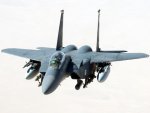http://america.aljazeera.com/opinions/2015/7/the-american-militarys-trillion-dollar-boondoggle.htmlMost Americans missed the news of two pairs of Russian Tupolev Tu-95 bombers that attempted to breach American airspace on the West Coast on the Fourth of July. The first incident occurred near Alaska, and the second the central Californian coast; the bombers were intercepted and escorted out of American airspace by F-22 and F-15 fighter planes.
Commenting on the incident, Retired Air Force Lt. General Thomas McInerny told The Washington Free Beacon: “it’s becoming obvious that Putin is testing Obama and his national security team.” The relevant question, though, to ask isn’t why Putin is attempting a banal revival of Cold War tensions — games of chicken between Russia and the West are no new thing, and Putin himself is far from inscrutable — but why the F-15 and F-22 planes played roles in the response.
Granted, the F-15 Eagle is considered one of the best fighter planes in history. In the time that it’s been flying, it has racked up 100 aerial combat victories, has supplied U.S. allies around the world, and is expected to be in use past the year 2025. But it was designed in the 1960s and first flew in 1972; it’s more than a bit past its prime.
The F-22 was created as its replacement in the early 2000s. By many accounts, the Raptor is a fantastic plane; the Air Force claims it “cannot be matched by any known or projected fighter aircraft.” But again, the aircraft isn’t perfect. Some of the more shocking safety allegations point to correlations with mental deficiencies, respiratory complications and neurological problems among its pilots. It’s also very, very expensive — about $150 million per plane. That doesn’t include the entire program development cost, either. It’s because of the steadily growing price tag that production on F-22s is currently halted.
The Raptor is emblematic of a long decline in the usefulness and cost efficiency of Air Force technology since the prime of the Cold War. The F-35 Lightning II multirole stealth fighter plane, the most expensive weapons system in the history of the planet, marks this trajectory’s nadir; mention of the plane in military circles usually has the term “boondoggle” following closely on its heel. The government spent $59 billion on development, $261 billion on procurement, and $590 billion for “operations and sustainment” of the F-35 in 2012. It still wasn’t ready to save us from the Russians on the Fourth of July.
An account of the F-35 failing to best the F-16 fighter in a mock-dogfight, published by Medium’s “War Is Boring” blog, suggests one reason why: It’s simply not meant to mix it up. The article emphasizes that the F-35’s best option in the test was to basically retreat; an allegation that received pushback from Lockheed Martin, which claimed that the F-35 isn’t made to engage in an old fashioned dogfight.
The F-35 “aren’t made so much to win dogfights with lesser planes as to blast them out of the sky from afar — before a visual combat situation has begun,” The American Interest reports. It’s unclear whether or not the plane can actually do that, since it gives off a massive heat signature, which might allow other planes to see it first. Regardless, the F-35 wasn’t built to engage in close combat to begin with, which might not make it ideal for intercepting Russian bombers (which could always possibly be accompanied by fighters themselves) and escorting them back into neutral air space.
What’s more, technical issues with the plane’s machinery persist despite the billions of dollars that were sunk into the F-35 since 2009. Its weapons delivery system is prone to tracking false targets because of software issues. The plane can’t fly within 25 miles of a storm. The pilot helmet display doesn’t work. The plane requires massive amounts of maintenance, far beyond anything predicted. It’s simply unsafe and unreliable. But it’s still successful within the demented logic of defense acquisition procedure: It makes massive amounts of money for contractors, subcontractors, investors, Congressmen and Department of Defense procurement officers. Performance is secondary; safety is practically an afterthought. The primary goal of military tech programs is to spin public money into private profit.
If the Pentagon were held to the same standards as the United States Post Office, the chorus of disgruntled conservatives would have long ago hit a crescendo. Part of the problem is that we want a military that can do everything, without going through the trouble of triaging our priorities or limiting our goals.
The recently released National Military Strategy lists America’s main enemies as China, Russia, Iran, violent extremists and so on, each requiring a different strategic approach (and the corresponding equipment) to defeat. That’s expensive. But, as the F-35 project shows, with subcontracts from 45 different states and its construction accounting for over 32,000 jobs, our real strategy is to emphasize the “industry” in defense industry.
The F-35 thus represents the current rationale animating modern American defense technology procurement. It prioritizes the transfer of vast amounts of public wealth into private hands, regardless of whether the product actually works.
So in a sense, it’s nice that the Russians are poking us, keeping us on our toes on a holiday weekend. Maybe we can get a new multi-billion dollar defense program out of it.
Less than 1% of the American population is active military personnel. In an America connected to the military, spending $1.5 trillion would be questioned. If the IRS or some other government agency spent $1.5 trillion it would make headline news. We don't insist on accountability with the military the same way we do with other government agencies. We can say that we "support" and "respect" the troops but the fact is we as a country are not involved with the less than 1% who fight our wars. It's this disengagement that leads to dangerous decisions that the public hardly notices.
Hopefully we can get a healthy discussion here about the military and the civilian-military gap


